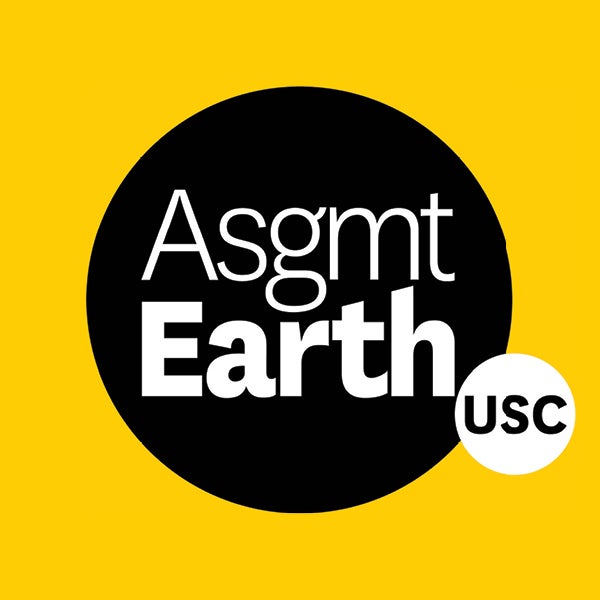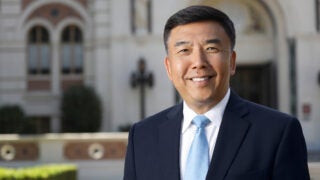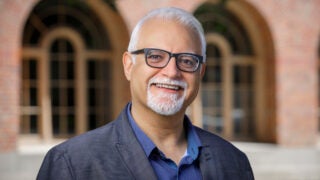USC cuts waste and water use in efforts to fulfill Assignment: Earth
Chief Sustainability Officer Mick Dalrymple highlights both visible and invisible reductions in waste in the latest annual report for sustainability.
USC has significantly ramped up waste reduction and awareness of pollution under USC President Carol L. Folt and her Assignment: Earth initiative.
 Since Folt’s arrival, the university has become home to an infrastructure of people, organizations, resources, research, outreach and communication dedicated to sustainability. This effort and its results are front and center in the newly released “Sustainability Progress Report” for fiscal year 2022.
Since Folt’s arrival, the university has become home to an infrastructure of people, organizations, resources, research, outreach and communication dedicated to sustainability. This effort and its results are front and center in the newly released “Sustainability Progress Report” for fiscal year 2022.
Collecting data in several strategic areas — water use, transportation, sustainable purchasing and others — the report details the progress made from July 2021 to June 2022. Compared to the benchmarks set in 2014, the university has reduced its environmental impact — sometimes dramatically.
Some highlights:
- Greenhouse gas emissions are down 31 percentage points since 2014.
- Waste diversion is nearly 50%, a 100% improvement from 2019.
- Potable water usage has decreased by 15% since 2014.
- Single-passenger car usage dropped 7%.
The numbers, initiatives and progress are overseen by Mick Dalrymple, USC’s first chief sustainability officer. After two years at the helm, he has a clear pilot’s view of university’s wins and challenges. We spoke to him about this year’s report, some sustainability misconceptions and how the university will meet the goals set out by Assignment: Earth.
What’s the message you take from this report?
The key takeaway from this report is that USC is making meaningful sustainability progress across all seven of these categories. Fiscal year 2022 was about establishing a solid foundation to build on to achieve our ambitious Assignment: Earth goals. We know where we need to go, it’s ambitious, and we’re learning how to accelerate our pace to get there.
The best news is that we’ve reduced our scope 1 and 2 greenhouse gas emissions by 31% since 2014, despite USC continuing to grow. The flip side is that we have so much further to go, and the road gets harder the further we get. But the atmosphere doesn’t care about our challenges. It just responds to our level of success or failure in getting to zero emissions.
What other achievements stand out?
The greenhouse gas reduction is definitely a big one. It has been made possible by the L.A. Department of Water and Power providing cleaner electricity and by making our campus buildings more energy efficient. And this year, we’re reaping the added benefits of the renewable energy deal we made with LADWP last fall. Meanwhile, USC Facilities Planning and Management is also implementing more LED lighting retrofits. The results from those accomplishments will show up in the numbers within next year’s report.
Another big accomplishment has been USC Hospitality purchasing a higher percentage of food from sustainable sources: 55%, up from 41% in 2020. This success has largely been driven by improvements in sourcing sustainable produce, dairy and seafood.
What are the most common misconceptions about USC’s status as a sustainability-minded institution?
Most people outside of USC don’t generally think of USC as a hotbed for sustainability. That is beginning to change, particularly because sustainability is such a high priority of President Carol L. Folt and we are doing more to talk about the vast number of things we are doing.
As the president has said, sustainability will become a backbone for everything we do, like diversity and artificial intelligence. As people begin to learn more about all the significant progress we are making operationally and some of the great sustainability research and teaching happening here, that misconception will fade away. Reputation lags reality. It will take time, more bold leadership and continued hard work.
When students, staff or members of the community reach out to you, what do they want to talk about? What are their questions, concerns and criticisms?
Students mostly inquire about USC’s commitment to recycling and composting. Waste is very tangible, and waste infrastructure is highly visible and not yet deployed consistently across campuses. Everyone touches waste every day, whereas energy and water are much less visible. I also hear about solar power and decorative fountains from students. Faculty and staff talk to me about waste, but I hear more from them about climate action, sustainable investing options in retirement plans, fossil fuel divestment, and native and drought-tolerant landscaping.
Do our sustainability challenges tend to be more visible than our achievements?
A lot of sustainability wins and challenges are not readily visible. This becomes a daily balancing act when working in sustainability. You’ve got heavy-lifting work that requires major investment but is behind the scenes, so it is hard to get people excited about it. And you’ve got other opportunities that are not necessarily going to move the numbers, but are very important to motivate people and for other reasons.
What sustainability investments are hiding in plain sight?
Compostable utensils and food containers used on campus cost far more than plastic and foam containers. Also, glass and aluminum single-use beverage bottles can be significantly more expensive than plastic. USC absorbs most of these costs and shares some with the end user because we are committed to making the right choices, even if they’re painful. We’re just not pushing costs off onto society or other species or future generations.
What are the highest hurdles in achieving zero waste (defined as 90% diverted from landfill)?
Eliminating plastic bottles has been a huge win, and it was a big lift made possible by many people working together. It was a leadership move, and we get questions about it regularly from other interested universities. But it is also one piece of a very complex puzzle. We’re at 47% diversion from landfill, and we need to get to 90% by 2028.
Ultimately, we need to do what is within our capacity to help build the circular economy. Things like building a robust surplus operation, modifying contracts to include what is called “extended producer responsibility,” exploring the purchase of services as an alternative to paying for the equipment that provides those services and changing the characteristics of what we buy.
All Trojans have a role to play here: We all have to commit to rethinking waste as a resource — first reduce and reuse, and then recycle and compost.



